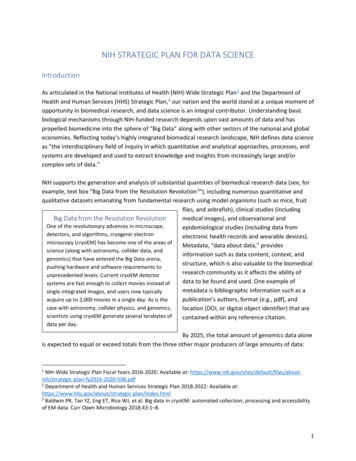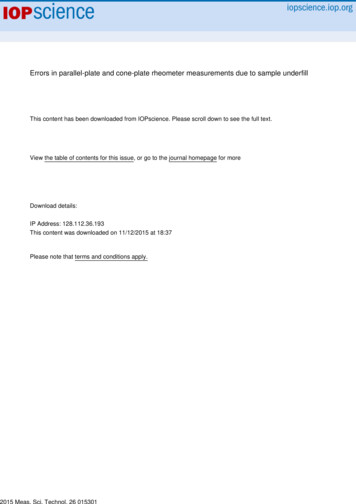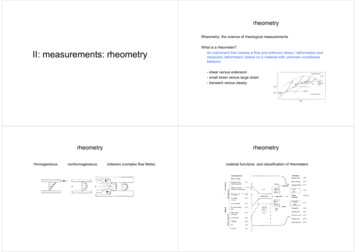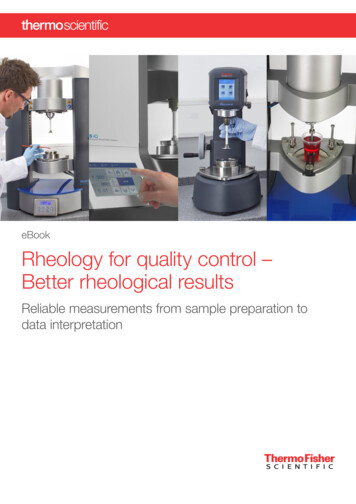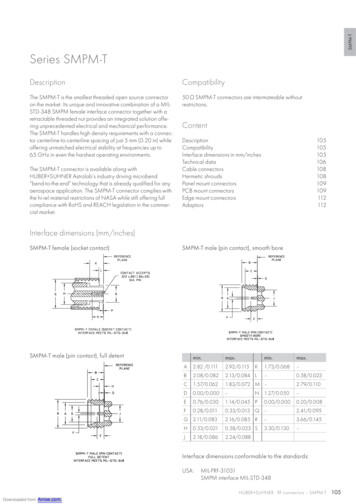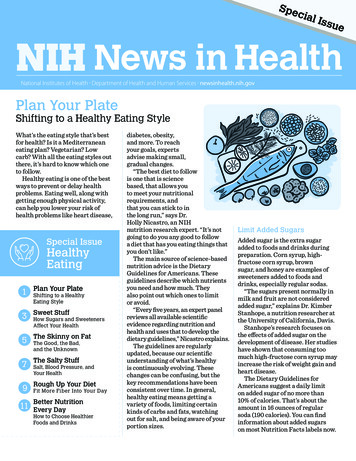
Transcription
Sp ecialI s suNational Institutes of Health Department of Health and Human Services newsinhealth.nih.govPlan Your PlateShifting to a Healthy Eating StyleWhat’s the eating style that’s bestfor health? Is it a Mediterraneaneating plan? Vegetarian? Lowcarb? With all the eating styles outthere, it’s hard to know which oneto follow.Healthy eating is one of the bestways to prevent or delay healthproblems. Eating well, along withgetting enough physical activity,can help you lower your risk ofhealth problems like heart disease,Special IssueHealthyEatingYour Plate1 PlanShifting to a HealthyEating Style3Sweet Stuff5The Skinny on Fat7The Salty Stuff9Rough Up Your Diet11How Sugars and SweetenersAffect Your HealthThe Good, the Bad,and the UnknownSalt, Blood Pressure, andYour HealthFit More Fiber Into Your DayBetter NutritionEvery DayHow to Choose HealthierFoods and Drinksdiabetes, obesity,and more. To reachyour goals, expertsadvise making small,gradual changes.“The best diet to followis one that is sciencebased, that allows youto meet your nutritionalrequirements, andthat you can stick to inthe long run,” says Dr.Holly Nicastro, an NIHnutrition research expert. “It’s notgoing to do you any good to followa diet that has you eating things thatyou don’t like.”The main source of science-basednutrition advice is the DietaryGuidelines for Americans. Theseguidelines describe which nutrientsyou need and how much. Theyalso point out which ones to limitor avoid.“Every five years, an expert panelreviews all available scientificevidence regarding nutrition andhealth and uses that to develop thedietary guidelines,” Nicastro explains.The guidelines are regularlyupdated, because our scientificunderstanding of what’s healthyis continuously evolving. Thesechanges can be confusing, but thekey recommendations have beenconsistent over time. In general,healthy eating means getting avariety of foods, limiting certainkinds of carbs and fats, watchingout for salt, and being aware of yourportion sizes.Limit Added SugarsAdded sugar is the extra sugaradded to foods and drinks duringpreparation. Corn syrup, highfructose corn syrup, brownsugar, and honey are examples ofsweeteners added to foods anddrinks, especially regular sodas.“The sugars present normally inmilk and fruit are not consideredadded sugar,” explains Dr. KimberStanhope, a nutrition researcher atthe University of California, Davis.Stanhope’s research focuses onthe effects of added sugar on thedevelopment of disease. Her studieshave shown that consuming toomuch high-fructose corn syrup mayincrease the risk of weight gain andheart disease.The Dietary Guidelines forAmericans suggest a daily limiton added sugar of no more than10% of calories. That’s about theamount in 16 ounces of regularsoda (190 calories). You can findinformation about added sugarson most Nutrition Facts labels now.e
2newsinhealth.nih.gov/special-issues“Anybody can improve their dietby substituting fruits and vegetablesfor sugar as their snacks, as part oftheir dessert, and as part of theirmeals,” says Stanhope. “Thereare no advantages of consumingadded sugar.”In general, healthy eatingmeans getting a varietyof foods, limiting certainkinds of carbs and fats,watching out for salt,and being aware ofyour portion sizes.Consider Your FatsFat is high in calories. Gettingtoo many calories can contributeto obesity, which raises your riskfor heart disease and other healthproblems. But there are differentkinds of fats.Fats that are liquid at roomtemperature, or oils, are generallyhealthier than those that are solid.Solid fats are found in high amountsNIH News in HealthISSN 2375-6993 (Print) ISSN 1556-3898 (Online)Editor Harrison Wein, Ph.D.Managing Editor Tianna Hicklin, Ph.D.Graphics Alan Defibaugh (illustrations),Bryan Ewsichek (design)This special issue is a collection of previouslypublished articles. However, articles wereupdated and re-reviewed by NIH expertsprior to inclusion. Published August 2019.Use our articles and illustrations in your ownpublication. Our material is not copyrighted.Please acknowledge NIH News in Health as thesource and send us a copy.newsinhealth.nih.govNIH Turning Discovery Into Health Office of Communications & Public LiaisonBuilding 31, Room 5B52Bethesda, MD 20892-2094email: nihnewsinhealth@od.nih.govphone: 301-451-8224in beef, chicken, pork, cheese, butter,and whole milk. Solid fats have moresaturated fats than liquid oils. Liquidoils—such as canola, corn, olive, orpeanut oil—have mostly unsaturatedor polyunsaturated fats.The dietary guidelines encourageconsuming liquid oils rather thansolid fats. Nicastro advises thatyou examine the fat content onthe Nutrition Facts label. Thelabel shows how much saturatedfat a product contains. Expertssuggest that you aim for gettingless than 10% of your calories fromsaturated fats.“For the average person, that’sgoing to be less than 20 grams ofsaturated fat per day,” Nicastro says.For example, a small cheeseburgermay have 5 grams of saturated fat,a typical cheeseburger may have13, and a double cheeseburger withbacon may have 24!Check Labels for SaltThe Nutrition Facts label also showssalt, or sodium. Experts advise youto limit salt, which tends to be veryhigh in processed foods.If you eat salty, highly processedfood, you can quickly go over thedaily limit of one teaspoon of salt(2,300 milligrams, or mg, of sodium).Two hot dogs might have 900 mg ofsodium. A can of ravioli might have1400 mg. Other examples of salty,highly processed foods are bacon,frozen pizzas, and salad dressings.“Stuff that comes ina box or a bag that hasa whole lot of differentingredients—many ofwhich you can’t readand understand orpronounce—those thingsare highly processedand generally bad foryour health.”Along with a lot of added salt,processed foods might havepreservatives, sweeteners,and other substances addedduring preparation.“Stuff that comes in a box ora bag that has a whole lot of differentingredients—many of which youcan’t read and understand orpronounce—those things are highlyprocessed and generally bad for yourhealth,” explains Dr. David C. Goff,Jr., a public health expert at NIH.Make a Meal Plan“Figuring out what to eat is lessthan half the battle,” Nicastro says.“Sticking to your plan is a biggerchallenge. So that’s why it helps tobe really prepared and plan ahead.”You’re much more likely to stickto your meal plan if you have healthyfood that is ready to go. Some peoplefind it helpful to prepare meals forthe week in advance so that healthyfood is within reach.The DASH eating plan is a goodstart. DASH was developed byNIH-supported researchers to helppeople lower blood pressure withoutmedicine, but it’s for anyone. Studieshave shown that it reduces the riskof many diseases.“The DASH diet is very flexiblebecause you can follow DASHwithout going to a specialty grocerystore. You can follow it with itemsthat are very familiar to most peoplein this country,” Nicastro says.The DASH eating plan is rich infruits, vegetables, whole grains,beans, seeds, nuts, and fish.Compared to the typical Americandiet, it’s lower in salt, added sugars,fats, and red meat. It’s also higherin fiber, potassium, magnesium,and calcium than the typicalAmerican diet.“Anybody can follow it, despitespecific preferences or culture,”Nicastro says. It even works forpeople who are vegetarian or onlyeat Kosher foods.
3newsinhealth.nih.gov/special-issuesYou can use the weekly DASHmenus and a form to track your foodand physical activity habits at t Expert AdviceThe Dietary Guidelines forAmericans are designed to helppeople avoid developing obesity,diabetes, and heart disease. Buteveryone is different. You may haveneeds and risks that aren’t like theaverage American. Talk to yourhealth care provider about yourunique nutritional needs.“A great resource for someoneto help you with your diet isa registered dietitian nutritionist,or DN,” Nicastro says.You can find this type of expert inyour area by visiting the Academyof Nutrition and Dietetics at www.eatright.org/find-an-expert.Wise ChoicesMake HealthyDiet Choices Eat a variety of foods—vegetables,fruits, whole grains, beans, nuts,seeds, lean meat, seafood, eggs,milk, yogurt, and cheese. Limit foods that are low invitamins and minerals. Avoid foods with added sugar. Replace foods containingsaturated fats (like butter orlard) with healthier unsaturatedfat options. Watch out for foods high in salt.Web LinksFor more about healthy eating, goto: r-plateSweet StuffHow Sugars and Sweeteners Affect Your HealthMost of us love sweet foodsand drinks. But after thatshort burst of sweetness,you may worry about howsweets affect your waistlineand your overall health. Issugar truly bad for us? Howabout artificial or low-caloriesweeteners? What havescientists learned about thesweet things that most of useat and drink every day?Our bodies need one typeof sugar, called glucose,to survive. “Glucose isthe number one foodfor the brain, and it’s anextremely importantsource of fuel throughout thebody,” says Dr. Kristina Rother,an NIH pediatrician and experton sweeteners.“Sugar has a badreputation that’s mostlydeserved, because weconsume too much of it.It’s now in just about everyfood we eat.”But there’s no need to add extraglucose to your diet. Your body canextract glucose from the sugarsand other carbohydrates inyour food. It can also produce newglucose, mostly in the liver. That’swhy you can survive for a long timewithout eating.Some sugars are found naturallyin foods, such as fruits, vegetables,and milk. “These non-processednatural foods are healthful additionsto your diet,” says Dr. AndrewBremer, a pediatrician and NIHexpert on sweeteners. “When youeat an orange, for instance, you’regetting a lot of nutrients and dietaryfiber along with the natural sugars.”Although sugar itself isn’t bad,Rother says, “sugar has a badreputation that’s mostly deserved,because we consume too much ofit. It’s now in just about every foodwe eat.”Added SugarsExperts agree that Americans eatand drink way too much sugar,and it’s contributing to the obesityepidemic. Much of the sugar weeat isn’t found naturally in foodbut is added during processingor preparation.Sugars are usually added tomake foods and drinks taste better.But such products can be high incalories and lack the healthfulDefinitionsGlucoseA type of sugar used by the body forenergy. When blood glucose levels get toohigh, it can damage tissues and organsover time.CarbohydratesA class of food molecule that includessugars, starches, and fibers.
4newsinhealth.nih.gov/special-issuesbenefits of fruits and other naturallysweet foods.Sugar-sweetened beverages likesoda, energy drinks, and sportsdrinks are the leading source ofadded sugars in the American diet.Juices naturally contain a lot ofsugar. But sometimes, even more isadded to make them taste sweeter.“Juices offer some vitamins andother nutrients, but in general,I think those benefits are greatlyoffset by the harmful effects of toomuch sugar,” Bremer says.Over time, excess sweetenerscan take a toll on your health.“Several studies have founda direct link between excesssugar consumption and obesityand cardiovascular problemsworldwide,” Bremer explains.Cutting BackBecause of these harmful effects,many health organizationsrecommend that Americans cutWise ChoicesCut Added Sugars Choose water, milk, or unsweetened tea or coffee instead ofsodas, sports drinks, energydrinks, and fruit drinks. Reduce sugar in recipes. If a recipesays 1 cup, use 2/3 cup. To enhance flavor, add vanilla,cinnamon, or nutmeg. Eat fresh, canned, frozen, anddried fruits without added sugar.Choose fruits canned in their ownjuice or water rather than syrup. Use fruits to top foods like cerealand pancakes rather than sugars,syrups, or other sweet toppings. Read the ingredients list to pickfood with little or no added sugar. Use the Nutrition Facts label tochoose packaged foods withless sugars.back on added sugars. About 15% ofthe calories in the American adultdiet now come from added sugars.Experts recommend a daily limiton added sugar of no more than10% of calories.But added sugars can be hard toidentify. On a list of ingredients,they may be listed as sucrose(table sugar), corn sweetener,high-fructose corn syrup, fruit-juiceconcentrates, nectars, raw sugar,malt syrup, maple syrup, fructosesweeteners, liquid fructose, honey,molasses, or anhydrous dextrose.Added sugar can also be listedwith any word ending in “-ose,” thechemical suffix for sugars. If anyof these words are among the firstfew ingredients on a food label, thefood is likely high in sugar. To findthe total amount of sugar in a food,look for “Sugars” on the NutritionFacts label under the category“Total Carbohydrate.”To find the total amountof sugar in a food, lookfor “Sugars” on theNutrition Facts labelunder the category“Total Carbohydrate.”Many people try cutting backon calories by switching fromsugar-sweetened to diet foods anddrinks that contain low- or nocalorie sweeteners. These artificialsweeteners—also known as sugarsubstitutes—are many timessweeter than table sugar, so smalleramounts can create the same levelof sweetness.People have debated the safety ofartificial sweeteners for decades.To date, researchers have found noclear evidence that any artificialsweeteners approved for use in theU.S. cause cancer or other serioushealth problems like birth defectsin humans.But can they help with weightloss? The scientific evidence ismixed. Some studies suggest thatdiet drinks can help you drop poundsin the short term. But their longterm effects on weight—and otherhealth aspects—are unclear. Rotherand other NIH-funded researchersare now working to betterunderstand the complex effects thatartificial sweeteners may have onthe human body.Studies of rodents and smallnumbers of people suggest thatartificial sweeteners can affectthe gut microbes that help us digestfood. This in turn can alter thebody’s ability to use glucose, whichmight then lead to weight gain. Butuntil further studies are done inpeople, the long-term impact of thesesweeteners on gut microbes andweight remains uncertain.Beyond the Gut“There’s much controversy aboutthe health effects of artificialsweeteners and the differencesbetween sugars and sweeteners,”says Dr. Ivan de Araujo at the MountSinai Icahn School of Medicine.“Some animal studies indicatethat sweeteners can producephysiological effects. But dependingon what kind of measurement istaken, including in humans, theoutcomes may be conflicting.”The key to good healthis eating a well-balanceddiet with a variety of foodsand getting plenty ofphysical activity.De Araujo and others have beenstudying the effects that sugars andlow-calorie sweeteners might haveon the brain. They are finding thatsugar and sweeteners tap differentlyinto the brain’s reward circuitry,with sugars having a more powerfuland pleasurable effect.“The part of the brain thatmediates the ‘I can’t stop’ kinds of
5newsinhealth.nih.gov/special-issuesbehaviors seems to be especiallysensitive to sugars and largelyinsensitive to artificial sweeteners,”de Araujo says. “Our long-termgoal is really to understand ifsugars or caloric sweeteners drivepersistent intake of food. If exposedto too much sugar, does the braineventually change in ways that leadto excess consumption? That’s whatwe’d like to know.”Some research suggests that theintensely sweet taste of artificial,low-calorie sweeteners can lead toa “sweet tooth,” or a preference forsweet things. This in turn mightlead to overeating. But more studiesare needed to confirm the relativeeffects of caloric versus non-caloricsweeteners.Don’t Sugarcoat It“In the long run, if you want tolose weight, you need to establisha healthy lifestyle that containsunprocessed foods, moderatecalories, and more exercise,”Rother says.When kids grow up eating a lot ofsweet foods, they tend to develop apreference for sweets. But if you givethem a variety of healthy foods likefruits and vegetables early in life,they’ll develop a liking for them, too.“It’s important for parents toexpose children to a variety of tastesearly on but realize that it oftentakes several attempts to get a childto eat such foods,” Bremer says.“Don’t give up too soon.”The key to good health is eatinga well-balanced diet with a variety offoods and getting plenty of physicalactivity. Focus on nutrition-richwhole foods without added sugars.Get tips on healthy eating and weightcontrol at go.usa.gov/xEjmc.Web LinksFor more about sugar andsweeteners, go to: tuffThe Skinny on FatThe Good, the Bad, and the UnknownFat is an essential nutrient forour bodies. It provides energy.It helps our guts absorb certainvitamins from foods. Butwhat types of fat should yoube eating? Are there any youshould avoid?Recommendations aboutdietary fat have shiftedover the last two decades.From the 1970s through the1990s, nutrition researchersemphasized eating a low-fat diet.This was largely becauseof concerns about saturatedfats, explains Dr. Alice H.Lichtenstein, who studies diet andheart health at Tufts University.Saturated fat that’s in thebloodstream raises the levels of LDLcholesterol—the “bad” cholesterol.This in turn raises the risk ofheart disease.But when people started followinglow-fat diets, they didn’t only cutsaturated fats. In many cases, theyreplaced healthy unsaturatedfats with processed carbohydrates,explains Lichtenstein.“Initially, when we recommendedcutting total fat, we did notanticipate people would replace itwith fat-free foods, like cookies,crackers, and ice cream, made withrefined grains and sugar,’” saysLichtenstein. “It is what we refer toas an unanticipated consequence.”As scientists have learned, thosereplacement calories matter. Studieshave shown that replacing saturatedfat with unsaturated fat reducesthe risk of heart disease. However,replacing saturated fat with simplecarbohydrates, such as added sugarand white bread, does not.“There’s still this misconceptionthat eating fat—any kind of fat—isbad, that it will lead to heart attacksor weight gain. That’s not true.People really should be encouragedto eat healthy fats,” says Dr.Frank Sacks, a nutrition expert atHarvard University.Healthy FatsResearch has shown thatunsaturated fats are good for you.These fats come mostly from plantsources. Cooking oils that are liquidat room temperature, such as canola,peanut, safflower, soybean, and oliveoil, contain mostly unsaturated fat.Nuts, seeds, and avocados are alsogood sources. Fatty fish—such assalmon, sardines, and herring—arerich in unsaturated fats, too.Large studies have found thatreplacing saturated fats in your dietwith unsaturated fats can reduceyour risk of heart disease by aboutthe same amount as cholesterollowering drugs.DefinitionsSaturated FatsFats that are solid at room temperature;found in butter, lard, full-fat milk andyogurt, full-fat cheese, and high-fat meat.Unsaturated FatsFats that tend to be liquid at roomtemperature; found in vegetable oils,seafood, and nuts.
6newsinhealth.nih.gov/special-issuesPeople should actively makeunsaturated fats a part of their diet,Sacks says. You don’t need to avoidhealthy fats to lose weight, he adds.In an NIH-funded study Sacksled, called the POUNDS LOST trial,people who ate higher-fat or lowerfat diets had similar rates of weightloss. They were also both successfulat keeping the weight off.“Low-fat diets have the sameeffect on body weight gain orweight loss as higher-fat diets orhigher-protein diets,” he explains.“For weight loss, it’s about gettinga handle on whatever foods in yourdiet are giving you excess calories.”Replacing “Bad” FatsSo are there fats you should avoid?Only a few years ago, doctors stillhad to advise people to avoidso-called trans fats in their diets.These largely manufacturedfats could be found in things likemargarine and many processedWise ChoicesChoosing Fats Eat plant-based foods. Plants cancontain healthy fats, as well asimportant vitamins and minerals. Include plant oils in your diet.Healthy choices include canola,peanut, olive, safflower, soybean,sunflower, corn, and nut oils. Replace foods containingsaturated fats (like butter orlard) with healthier unsaturatedfat options. Limit fatty red meat. Instead, eatmore fish, poultry, or lean meats. Reduce sugars and replaceprocessed grains, such as whitebread and white rice, with wholegrains and brown rice. The bodycan use simple carbohydrates tomake saturated fats.foods. They have been shown toraise the risk of heart disease.Since 2015, the U.S. Food andDrug Administration has takensteps to remove artificial trans fatsfrom the food supply. Most trans fatsnow in food come from the smallamounts found naturally in animalproducts, like meat and butter.Experts already recommend thatpeople limit their intake of animalfats. “So that takes care of thosetrans fats as well,” Lichtenstein says.As for saturated fat, it’scomplicated. Not all of the saturatedfat in the bloodstream comesfrom the saturated fat that we eat,explains Dr. Ronald Krauss, whostudies cholesterol at the UCSFBenioff Children’s Hospital Oakland.Instead, it’s produced when the bodybreaks down simple carbohydratesand sugars. That’s one reason whyreplacing saturated fat in the dietwith simple carbohydrates doesn’treduce the risk of heart disease.Nutrition experts still recommendthat people minimize the amountof saturated fat in the diet. Butresearchers are now looking atwhether the type of food thatsaturated fat is found in matters.For example, the influence of plantbased saturated fats, such as those incoconut and palm oil, is still unclearand being researched further.Recent studies suggest that somefull-fat dairy products, such asyogurt, may actually have benefitsfor the heart, Krauss says.Krauss and his colleagues recentlyran a small study looking at theeffects of replacing some of thesugar allowed in the DASH diet withsaturated dairy fats. The DASH dietwas developed by NIH to help lowerblood pressure.Participants who ate saturateddairy fat instead of sugar had lessof a fat called triglycerides in theirbloodstream. The higher-fat dietwas also as effective at loweringblood pressure as the standardDASH diet.More research is needed tounderstand which foods that containsaturated fats may influence thebody in a good way.Individual NeedsResearchers know that there are bigdifferences in how people’s bodiesreact to different types and amountsof fat. But they still don’t know why.Studies have found that genes aren’tlikely responsible, Sacks explains.Lichtenstein and Krauss are bothstudying how the microbes that livein the gut interact with dietary fats.The makeup of the microbiome—allthe microorganisms that normallylive in the body, mainly in the gut—can differ widely between people.It may turn out that different typesof gut bacteria produce differentcompounds from fats. Thesecompounds could then affect thebody in different ways, Lichtensteinexplains. Or different types offats could promote the growth ofdifferent bacteria in the gut, whichmay then have varying effectson health.“We just don’t know yet, but thereis tremendous interest in tryingto understand the role of the gutmicrobiome in human health,”she says.If there’s one thing that theresearch has shown, it’s that thescience of diets is very complex.Experts have moved away fromfocusing on single nutrients—suchas fat—by themselves. Instead, Sackssays, researchers now talk abouthealthy dietary patterns: ways ofeating that take all aspects of thediet into account. Learn more abouthealthy dietary patterns at health.gov/dietaryguidelines.Web LinksFor more about dietary fat, go y-fat
7newsinhealth.nih.gov/special-issuesThe Salty StuffSalt, Blood Pressure, and Your HealthSalt is essential to our body’s fluids.That’s likely why we evolved to enjoyits taste. On the other hand, anyonewho’s gotten a mouth full of seawaterknows that too much salt tastesterrible. Maybe your body’s trying totell you something. It turns out thattoo much salt can lead to a host ofhealth problems.Dietary salt, or table salt, ismade from two chemical elements:sodium and chloride. That’s why itschemical name is sodium chloride.It’s the sodium part that’s been tiedto health problems. But since most ofthe sodium we ingest is from salt, it’sdifficult to separate the effects of saltand sodium in many studies.Health Effects“The best-known effect of sodium onhealth is the relationship betweensodium and blood pressure,”explains Dr. Holly Nicastro, an NIHnutrition research expert. Dozens ofstudies, in both animals and people,have linked a higher salt intake withhigher blood pressure. Reducing saltintake, on the other hand, lowersblood pressure.Blood pressure is the force ofblood pushing against the walls ofarteries as the heart pumps outblood. When this pressure rises—acondition called high blood pressure,or hypertension—it can damagethe body in many ways over time.High blood pressure has been linkedto heart disease, stroke, kidneyfailure, and other health problems.There are two blood pressurenumbers, and they’re usuallywritten with one above or beforethe other. Systolic, the first, is thepressure when the heart beats,pumping blood through the arteries.Diastolic is the pressure when theheart is at rest between beats. Thenumbers 120/80 mmHg are the onesyou should aim to keep your bloodpressure below.Some research also suggeststhat excessive sodium intakeincreases the risk of stomach cancer.Scientists continue to investigatethis possible connection.Researchers do know that noteveryone is equally sensitive to salt.“From our experiments, we knowthere’s lots of variation in the bloodpressure response to sodium intake,”Nicastro says. Certain groups ofpeople see greater reductions inblood pressure when they lower theirsalt intake: African-Americans,older adults, and people with bloodpressure above normal.“Within those groups, there’sa lot of variation between people,”Nicastro says. But about 1 in 3 adultsnationwide has high blood pressureright now. Another third haveelevated blood pressure, meaningtheir numbers are high enough toput them at risk to develop highblood pressure. In light of this, shesays, “It’s really important for themajority of U.S. adults to reducetheir blood pressure.”How Much Salt?Experts recommend that adults takein less than 2,300 milligrams (mg) ofsodium a day—that’s what’s in about6 grams of salt, or about a teaspoon.People with high blood pressureDefinitionsArteriesThe vessels that carry blood from yourheart throughout your body.StrokeWhen normal blood flow to the brain isstopped, usually by ruptured or blockedblood vessels.
8newsinhealth.nih.gov/special-issuesshould shoot for 1,500 mg. But rightnow, American adults eat an averageof about 3,600 mg of sodium per day.Dr. Kirsten Bibbins-Domingoat the University of California,San Francisco, led an NIH-fundedstudy that used computer modelingto explore the effects of a modestreduction in salt intake in the UnitedStates. The researchers found thatreducing salt intake by 3 grams perday (1,200 mg of sodium) could cutthe number of new cases of heartdisease each year by as many as120,000, stroke by 66,000, and heartattack by nearly 100,000. It couldalso prevent up to 92,000 deathseach year.All segments of the populationwould benefit, with AfricanAmericans having the greatestimprovements overall. Womenwould particularly benefit fromreductions in stroke, older adultsWise ChoicesCut Back on Sodium Look at Nutrition Facts labels andtry to choose prepared foods thathave less than 5% of the Daily Valueof sodium per serving. Use fresh poultry, fish, and leanmeat, rather than canned, smoked,or processed. Choose fresh or frozen vegetablesthat have no added salt. Rinse canned foods to removesome of the sodium. Add less salt—or none—whencooking. Use reduced-sodium bouillon,dressings, and sauces like soy sauce. Use fresh herbs and buy spices andblends without added salt. Cook at home instead of eating out,when possible. But when eatingout, ask that no extra salt be addedto your food.from a decline in heart disease, andyounger adults from fewer deaths.Reducing SaltSome countries have tried to lowersalt intake using various strategies,such as working with industry toreduce the salt content in processedfoods, requiring labels on ready-toeat foods, and educating the public.The UK achieved a 15% reduction insalt consumption between 2003 and2011. During this time, deaths fromstroke fell by 42% and from heartdisease by 40%.But wouldn’t we miss the taste?“Several studies have shown that asyou gradually reduce sodium intake,you lessen your desire for salty food,”Nicastro says. And surveys of peopleacross the UK found that mostpeople didn’t notice any difference inthe taste of their food.“A very modest decrease in theamount of salt, hardly detectablein the taste of food, can havedramatic health benefits for theU.S.,” Bibbins-Domingo stresses.The salt we add to our foodactually accounts for about 10%of our salt consumption. Most ofthe salt we eat comes in processedfoods from stores, restaurants, anddining halls. You may already knowthat fast food, cold cuts, and cannedfoods tend to have a lot of salt.“Many people don’t realize thata lot of our salt is from breads andcereals,” Bibbins-Domingo says.Studies have found that about 15 to20% of the sodium in the averageAmerican’s diet comes from grainproducts, such as breads, cereals,crackers, and chips.“In terms of advice, I think thebest guidance we have is for peopleto pay attention to nutrition factson the labels,” Nicastro says. “Thepercent daily value is a better guidethan the language that’s used on foodlabels like ‘low-salt.’ These labelscan be confusing, because they havevery defined technical meanings.”Try to select foods, she advises, withless than 5% of the daily value of saltp
“The DASH diet is very flexible because you can follow DASH without going to a specialty grocery store. You can follow it with items that are very familiar to most people in this country,” Nicastro says. The DASH eating plan is rich in fruits, vegetables, whole grains, beans
